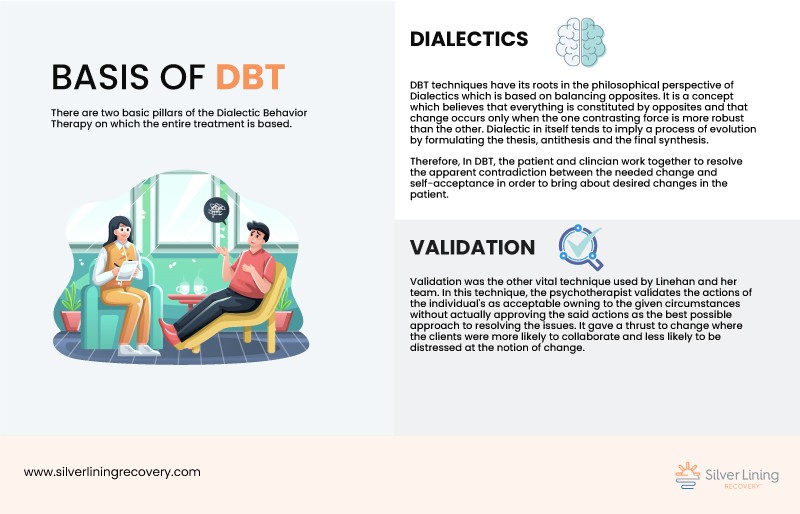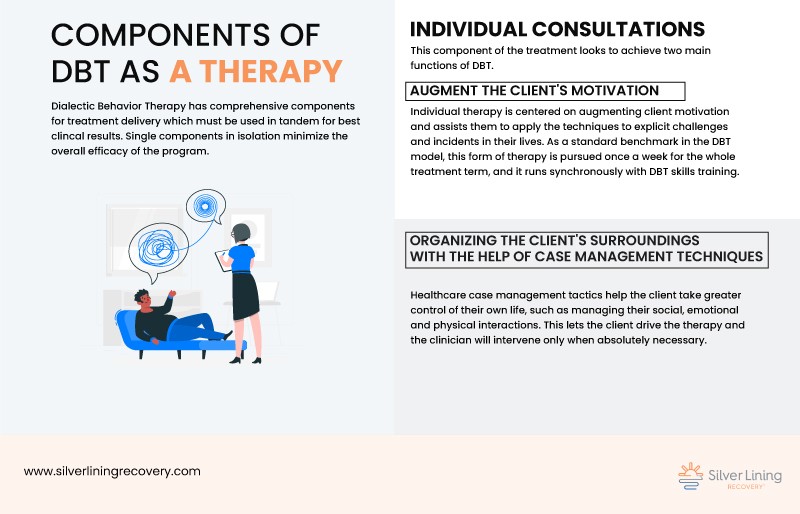

What is Dialectic Behavior Therapy or DBT?
Dialectic Behavioral Therapy is a modified form of Cognitive Behavioral Therapy (CBT). The primary outcomes of the DBT training programs are to convey to people how to live mindfully in the present moment, healthily deal with stress, regulate and have control over emotions, and constantly work on improving relationships with others.
It is an evidence-based psychotherapy designed to help people enhance their intellectual and emotive parameters by learning about the causes that steer them to volatile states. The treatment also looks to assess the plausible coping skills to use in case of specific thoughts, events, feelings, and behaviors to avoid undesired reactions. DBT typically requires that a thorough approach be implemented employing all elements of therapy.
Dialectic Behavioral Therapy has shown promise to be effective with individuals who don’t respond well to other traditional therapies. DBT could be used when treating suicidal and other self-destructive behaviors. DBT has also been refined to be utilized in several other therapy contexts and for various other troubles. Besides the commitment issue, DBT can be applied to many different circumstances, and there’s research to indicate that it has been effective for assorted troubles, including for those who aren’t normally regarded as good therapy candidates, like individuals with bipolar disorder. DBT has also been shown to be effective in various treatment settings with a range of populations. Comprehensive DBT has been shown to have significant practical utility for decreasing violence, insomnia, substance abuse, and self-harm.
Background
Dr. Marsha M. Linehan developed Dialectic Behavior Therapy in the late 1980s. It started as a special effort to address the “extra” needs of the patients suffering from Emotional Instability Disorder (commonly known as Borderline Personality Disorder) who were not responding to CBT alone. As a part of their understanding, they added treatments and techniques to address the exclusive needs of these patients and formulated this scope of treatment.


Basis of DBT
There are two basic pillars of the Dialectic Behavior Therapy on which the entire treatment is based.
Dialectics
DBT techniques have its roots in the philosophical perspective of dialectics which is based on balancing opposites. It is a concept which believes that everything is constituted by opposites and that change occurs only when the one contrasting force is more robust than the other. Dialectic in itself tends to imply a process of evolution by formulating the thesis, antithesis and the final synthesis.
Therefore, in DBT, the patient and clinician work together to resolve the apparent contradiction between the needed change and self-acceptance in order to bring about desired changes in the patient.
Validation
Validation was the other vital technique used by Linehan and her team. In this technique, the psychotherapist validates the actions of the individual’s as acceptable owing to the given circumstances without actually approving the said actions as the best possible approach to resolving the issue. It gave a thrust to change where the clients were more likely to collaborate and less likely to be distressed at the notion of change.
Components of DBT as a therapy
Dialectic Behavior Therapy has comprehensive components for treatment delivery which must be used in tandem for best clinical results. Single components in isolation minimize the overall efficacy of the program.
Individual consultations:This component of the treatment looks to achieve two main functions of DBT.
- Augment the client’smotivation
Individual therapy is centered on augmenting client motivation and assists them to apply the techniques to explicit challenges and incidents in their lives. As a standard benchmark in the DBT model, this form of therapy is pursued once a week for the whole treatment term, and it runs synchronously with DBT skills training.
- Organizing the client’s surroundings with the help of Case Management techniques
Healthcare case management tactics help the client take greater control of their own life, such as managing their social, emotional and physical interactions. This lets the client drive the therapy and the clinician will intervene only when absolutely necessary.
GroupSkills Training
This component of the DBT treatment looks to understand and make clear that the origin of the problematic behaviors is the coping mechanism for specific situations or attempt to resolve an issue. These behaviors may deliver short-term relief; however, they often are not effective in the long run.
The basic assumption in DBT training is that the individuals are doing their best under the given circumstances and need to learn new behaviors in the proper contexts to enhance their situation handling capabilities.
Four essential strategies taught in Dialectic Behavioral Therapy at our center are:
- Mindfulness: the practice of being in the NOW, the current moment.
- Anxiety and pain Tolerance: the focus is on how to accept any situation, tolerate pain, and not look to change it
- Efficacy of interpersonal communication: aims to make individuals assertive in all relationships while maintaining self-respect and positive relationships with others. Learning to say no is an integral part.
- Emotion Regulation: deals with internalizing and coping with adverse emotions and reducing one’s emotional susceptibility by increasing encouraging emotional experiences.
During the skills training, the main therapist uses home assignments to help individuals practice the acquired skills in their day-to-day lives. It is often taught in groups.
Real-time coaching
This component ensures the application of the learned skills in everyday experiences, which understandably have bouts of difficult situations. Clients have access to clinicians between sessions to receive in-the-moment help at their peak distress times.
DBT therapist’s consultation group
DBT programs could be taxing on the therapists as well. The DBT discussion team is essentially to keep aligning the therapists with the goals, monitor their reliability to the ongoing treatment, constantly develop and enhance their skills, and support their motivation to work with difficult-to-treat, high-risk clients.
If you have made up your mind to give another chance to your relationships, speak with our experts and consultants at Silver Lining, Orange County, California. We will help you ascertain if Dialectic Behavior Therapy is the right option for you and suggest the right path to recovery from substance abuse.
The 12-Step Program in California can be a friendly guide in the individual’s recovery journey.
Contact Silver Lining Recovery in case you are looking for 12-Step Treatment Centers in California.
